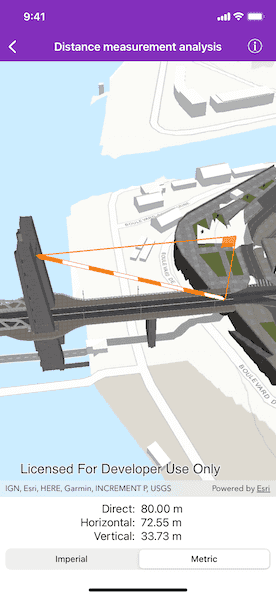Measure distances between two points in 3D.

Use case
The distance measurement analysis allows you to add to your app the same interactive measuring experience found in ArcGIS Pro, City Engine, and the ArcGIS API for JavaScript. You can set the unit system of measurement (metric or imperial). The units automatically switch to one appropriate for the current scale.
How to use the sample
Choose a unit system for the measurement in the segmented control. Long press any location in the scene to start measuring. Then drag to an end location, and lift your finger to complete the measure. Tap a new location to clear and start a new measurement.
How it works
- Create an
AGSAnalysisOverlayobject and add it to the analysis overlay collection of theAGSSceneViewobject. - Specify the start location and end location to create an
AGSLocationDistanceMeasurementobject. Initially, the start and end locations can be the same point. - Add the location distance measurement analysis to the analysis overlay.
- The
measurementChangedHandlercallback will fire if the distances change. You can get the new values for thedirectDistance,horizontalDistance, andverticalDistancefrom the parameters provided by the callback. The distance objects contain both the scalar value and unit of measurement.
Relevant API
- AGSAnalysisOverlay
- AGSLocationDistanceMeasurement
- AGSMeasurementChangedEvent
Additional information
The AGSLocationDistanceMeasurement analysis only performs planar distance calculations. This may not be appropriate for large distances where the Earth's curvature must be considered.
Tags
3D, analysis, distance, measure
Sample Code
//
// Copyright © 2018 Esri.
//
// Licensed under the Apache License, Version 2.0 (the "License");
// you may not use this file except in compliance with the License.
// You may obtain a copy of the License at
//
// http://www.apache.org/licenses/LICENSE-2.0
//
// Unless required by applicable law or agreed to in writing, software
// distributed under the License is distributed on an "AS IS" BASIS,
// WITHOUT WARRANTIES OR CONDITIONS OF ANY KIND, either express or implied.
// See the License for the specific language governing permissions and
// limitations under the License.
//
import UIKit
import ArcGIS
class DistanceMeasurementAnalysisViewController: UIViewController, AGSGeoViewTouchDelegate {
/// The scene displayed in the scene view.
let scene: AGSScene
/// The location distance measurement analysis.
let locationDistanceMeasurement: AGSLocationDistanceMeasurement
/// The scene view managed by the view controller.
@IBOutlet weak var sceneView: AGSSceneView!
@IBOutlet weak var directMeasurementLabel: UILabel!
@IBOutlet weak var horizontalMeasurementLabel: UILabel!
@IBOutlet weak var verticalMeasurementLabel: UILabel!
required init?(coder: NSCoder) {
// Create the scene.
scene = AGSScene(basemapStyle: .arcGISTopographic)
// The elevation image service URL.
let elevationServiceURL = URL(string: "https://scene.arcgis.com/arcgis/rest/services/BREST_DTM_1M/ImageServer")!
// Create the surface and set it as the base surface of the scene.
let elevationSource = AGSArcGISTiledElevationSource(url: elevationServiceURL)
let surface = AGSSurface()
surface.elevationSources.append(elevationSource)
scene.baseSurface = surface
// The URL of the scene service for buildings in Brest, France.
let brestBuildingsServiceURL = URL(string: "https://tiles.arcgis.com/tiles/P3ePLMYs2RVChkJx/arcgis/rest/services/Buildings_Brest/SceneServer/layers/0")!
// Create the building layer and add it to the scene.
let buildingsLayer = AGSArcGISSceneLayer(url: brestBuildingsServiceURL)
// Offset the altitude to avoid clipping with the elevation source.
buildingsLayer.altitudeOffset = 2
scene.operationalLayers.add(buildingsLayer)
// Create the location distance measurement.
let startPoint = AGSPoint(x: -4.494677, y: 48.384472, z: 24.772694, spatialReference: .wgs84())
let endPoint = AGSPoint(x: -4.495646, y: 48.384377, z: 58.501115, spatialReference: .wgs84())
locationDistanceMeasurement = AGSLocationDistanceMeasurement(startLocation: startPoint, endLocation: endPoint)
super.init(coder: coder)
locationDistanceMeasurement.measurementChangedHandler = { [weak self] _, _, _ in
DispatchQueue.main.async {
self?.updateMeasurementLabels()
}
}
}
override func viewDidLoad() {
super.viewDidLoad()
// Configure the scene view.
sceneView.scene = scene
sceneView.touchDelegate = self
let lookAtPoint = AGSEnvelope(min: locationDistanceMeasurement.startLocation, max: locationDistanceMeasurement.endLocation).center
let camera = AGSCamera(lookAt: lookAtPoint, distance: 200, heading: 0, pitch: 45, roll: 0)
sceneView.setViewpointCamera(camera)
// Create the analysis overlay with the location distance measurement
// analysis and add it to the scene view.
let analysisOverlay = AGSAnalysisOverlay()
analysisOverlay.analyses.add(locationDistanceMeasurement)
sceneView.analysisOverlays.add(analysisOverlay)
updateMeasurementLabels()
// Add the source code button item to the right of navigation bar.
(navigationItem.rightBarButtonItem as! SourceCodeBarButtonItem).filenames = ["DistanceMeasurementAnalysisViewController"]
}
@IBAction func unitSystemSegmentedControl(_ sender: UISegmentedControl) {
guard let unitSystem = AGSUnitSystem(rawValue: sender.selectedSegmentIndex) else { return }
locationDistanceMeasurement.unitSystem = unitSystem
}
let measurementFormatter: MeasurementFormatter = {
let measurementFormatter = MeasurementFormatter()
measurementFormatter.numberFormatter.minimumFractionDigits = 2
measurementFormatter.numberFormatter.maximumFractionDigits = 2
return measurementFormatter
}()
func updateMeasurementLabels() {
guard isViewLoaded else { return }
if locationDistanceMeasurement.startLocation != locationDistanceMeasurement.endLocation,
let directDistance = locationDistanceMeasurement.directDistance,
let horizontalDistance = locationDistanceMeasurement.horizontalDistance,
let verticalDistance = locationDistanceMeasurement.verticalDistance {
directMeasurementLabel.text = measurementFormatter.string(from: Measurement(distance: directDistance))
horizontalMeasurementLabel.text = measurementFormatter.string(from: Measurement(distance: horizontalDistance))
verticalMeasurementLabel.text = measurementFormatter.string(from: Measurement(distance: verticalDistance))
} else {
directMeasurementLabel.text = "--"
horizontalMeasurementLabel.text = "--"
verticalMeasurementLabel.text = "--"
}
}
// MARK: AGSGeoViewTouchDelegate
func geoView(_ geoView: AGSGeoView, didTapAtScreenPoint screenPoint: CGPoint, mapPoint: AGSPoint) {
sceneView.screen(toLocation: screenPoint) { [weak self] mapLocation in
guard let measurement = self?.locationDistanceMeasurement else { return }
if measurement.startLocation != measurement.endLocation {
measurement.startLocation = mapLocation
}
measurement.endLocation = mapLocation
}
}
func geoView(_ geoView: AGSGeoView, didLongPressAtScreenPoint screenPoint: CGPoint, mapPoint: AGSPoint) {
sceneView.screen(toLocation: screenPoint) { [weak self] mapLocation in
guard let measurement = self?.locationDistanceMeasurement else { return }
if measurement.startLocation != measurement.endLocation {
measurement.startLocation = mapLocation
}
measurement.endLocation = mapLocation
}
}
func geoView(_ geoView: AGSGeoView, didMoveLongPressToScreenPoint screenPoint: CGPoint, mapPoint: AGSPoint) {
sceneView.screen(toLocation: screenPoint) { [weak self] mapLocation in
self?.locationDistanceMeasurement.endLocation = mapLocation
}
}
}
extension Measurement where UnitType == Unit {
/// Creates a measurement from an ArcGIS distance.
///
/// - Parameter distance: An `AGSDistance` object.
init(distance: AGSDistance) {
let unit = Unit(symbol: distance.unit.abbreviation)
let value = distance.value
self.init(value: value, unit: unit)
}
}